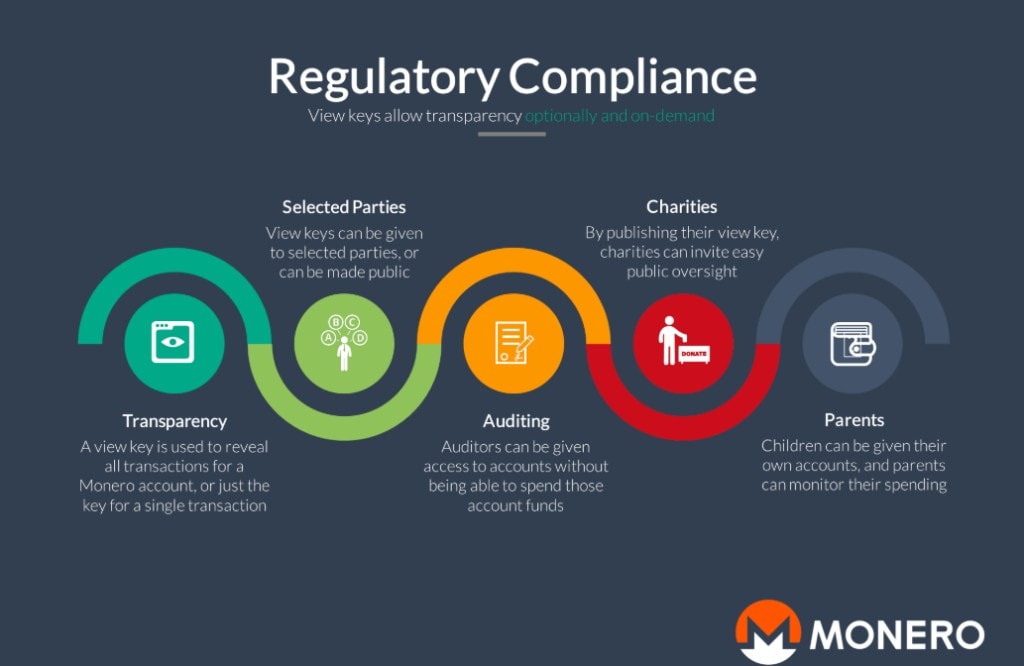What is Monero?
With the advent of Bitcoin and it’s underlying technology, blockchain, it ushered in a new era of trustless transactions that’s transparent for anyone to access and see. This transparency can be both good and bad. Although Bitcoin provides some level of anonymity through a series of characters and letters as wallet addresses, all the transaction info is public for everyone to see including sender and receiver address, transaction amount, as well as the current balance. So once someone tags an address to you, they will be able to go through the wallet’s transaction details.
Monero (XMR) is a privacy focused cryptocurrency intentionally made to be opaque while still embodying blockchain’s trustless nature. This means that even though the transactions and account balances are hidden, they can still mathematically prove that the transactions did happen and that there aren’t more coins in circulation than the system says. Monero is designed to disguise the transaction amount and identity of sender and recipient through their Ring CT (Ring Confidential Transaction) and Stealth address technology.
Although Bitcoin was initially the preferred currency in black markets and deep web, authorities have actually been able to track Bitcoin movements of these addresses and found out the people behind these addresses by recognizing patterns, trends and working with some exchanges. This is why Monero’s XMR token has been gaining ground because unlike Bitcoin, it’s truly anonymous. It has been increasingly used in drug and gambling related activities. It’s no wonder it’s been in hot water with regulatory bodies and authorities because of its anonymous nature. This has also led to multiple cryptocurrency exchanges such as OKEX, Upbit and Huobi Korea to remove XMR from their trading platforms in a move to be more regulatory compliant.
Among all privacy focused coins, it has the highest market cap at around $1 Billion and is ranked number 16. It was originally called BitMonero but has changed its name since. Although it is not a fork of Bitcoin, its code was instead forked from another cryptocurrency project called Bytecoin. Monero was launched in April 2014. It did not have an ICO, pre mine nor a founders’ fund.
The team behind Monero is composed of both known and anonymous members. Most well known of which is Riccardo “fluffypony” Spagni who is currently the lead maintainer of Monero. He got involved with Bitcoin and cryptocurrencies as early as 2011, a true pioneer in this space.
Monero’s developers have been hard at work and have been consistently delivering major developments to the project. They implemented the bulletproof upgrade which decreased block size by 80%. KOVRI which is a C++ implementation of the I2P network is in heavy development and is scheduled to be released within the year. With this, they are able to disguise mining activities, metadata leakage and associations between particular transaction IDs and your IP address.
The project is completely open sourced with anonymous founders. This gives more decentralization to the project since there are no founders who can become single points of failure. It’s community is also very active supporting the team through crowdfunding campaigns and donations.
What sets Monero apart?
Monero is secure and decentralized
Monero is a decentralized cryptocurrency, which means that it is a secure form of digital cash that is supported by a network of miners spread all over the world. Unlike centralized companies, there is not one single point of failure. All transactions are verified by this distributed network before it is immutably recorded on the blockchain.
Monero is private
Monero’s ring signatures, ring confidential transactions, and stealth address features to disguise transaction details such as the origins, amounts, and destinations of all transactions. All Monero transactions are automatically private since this is not an opt in feature unlike other privacy cryptocurrencies. This means that users will be able to use Monero to conduct private transactions away from the prying eyes of third parties. An example use case is in concealing the identity of your suppliers from other people. However, users have the option to share certain details of a transaction to others, if they wish, through what is called a view key.

Monero is untraceable
Sending and receiving addresses as well as transacted amounts are obfuscated by default. Transactions on the Monero blockchain cannot be linked to a particular user or real-world identity.
Monero is fungible
Fungibility means that every single coin is the same. Gold is fungible since two gold bars that are the same weight and come from the same manufacturer are indistinguishable while dollar bills are not fungible given they have unique serial numbers for each note. In order to be completely private, Monero is fungible by default. Units of Monero cannot be blacklisted by vendors or exchanges due to their association in previous transactions. Bitcoin on the other hand is not fungible since you know where it came from. This has led to the rise of clean Bitcoins (freshly minted from miners) and dirty Bitcoins (Bitcoins that have been associated with scandals or hacks).

How does Monero Work?
Proof of Work
Monero uses a proof of work consensus mechanism just like Bitcoin. Miners in the network provide hashpower to keep the network secure while verifying transactions. They are currently running the RandomX mining algorithm which was introduced last December 2019. It uses a random code execution together with memory-focussed techniques in an effort to combat ASIC machines.
ASIC (application-specific integrated circuits) devices are optimized for professional mining operations. ASICs can do only one thing, which is mining, and they do it really well. They provide orders of magnitude more in terms of performance compared to CPUs and GPUs. With the rise of ASIC, it has become almost impossible to mine cryptocurrencies like Bitcoin and Ethereum profitably and thus centralizing the power to big miners and mining pools. Monero has been one of the very few projects that have constantly been updating their hashing algorithm to fend off these ASICs. It’s a cat and mouse game where other cryptocurrencies have given up since ASIC engineers always find a way to make an ASIC for different hashing algorithms. This is the third time they have updated their hashing algorithm.
Ring CT (Confidential Transactions)
Monero introduced Ring CT in January of 2017 in an effort to further increase the privacy features of Monero. RingCT introduces an improved version of ring signatures called “A Multi-layered Linkable Spontaneous Anonymous Group signature”. With this upgrade, transaction amounts, origins and destinations are hidden with reasonable efficiency and still verifiable. Ring Signatures mixes an individual’s real signature into a group of valid signatures. From this pool, there is no way to tell which one is the real identity of the sender.
Stealth Addresses
Whenever a transaction happens, the sender automatically creates a random one-time use address on behalf of the recipient. Even though the recipient uses just one receiving address, he will receive the payment from different unique addresses which are all happening behind the scenes. Using this, only the sender and receiver know the details of the transaction.
After creating a Monero account, you will get a private view key, a private spend key, and a Public Address. The spend key is used to send payments, the view key is used to display incoming transactions entering your account, and the public address is for receiving payments. Both the spend key and view key are used to build your Monero address. You can have a “watch only” wallet that only uses the view key.
Key Metrics
| April 2020 | |
| Price of XMR | $53.61 |
| Avg. Block time | 2 min |
| Reward per block | 1.75 |
| Circulating supply | 17,522,415 |
| Max Supply | inflationary |
| Avg. Transactions per block | 15 |
| Avg. Transaction size | unknown |
| Avg. Transaction Fee | 0.00027 XMR ($0.014 USD) |
| Hash Rate | 1.28 Ghash/s |
| Market cap rank | 16 |
Monero’s Timeline
April 2014 – Monero blockchain launched.
January 2017 – Confidential Transactions and Ring Signatures adopted, known collectively as Ring Confidential Transactions (RingCT).
October 2018 – Bulletproof (zero knowledge proofs) adopted on chain.
Nov 2019 – Adopted the RandomX mining algorithm
Where can I buy XMR?
Auto generated
How to properly store XMR?
Since Monero is operating its own blockchain network, it will have it’s own address that is different from other blockchain networks like Bitcoin or Ethereum. Monero’s raw address file consists of 95 characters starting with the number 4. Monero does offer a more legible address called Open Alias address which will be attached to your raw Monero address. For example, Monero donations can be sent to donate@getmonero.org or donate.getmonero.org instead of the 95 character address.
Hardware Wallets – auto generated
Online Wallets – auto generated
Real world use cases (Who’s using it?)
Although Monero is oftentimes portrayed as a currency used for illegal activities, it is also being accepted to pay for everyday goods and services. Some examples include VPN hosting companies, digital gift cards and gaming websites. The Monero team publishes a list of merchants, services as well as exchanges that accept Monero in the link: Merchants & Services
Pros and Cons
Pros
- Private transactions
- Relatively fast transaction
- Low transaction fees
- Active and decentralized development team
- ASIC resistant Mining algorithm which is constantly being updated by the team
Cons
- Heavy scrutiny from regulators
- Negative public perception
- Low adoption
FAQ
Confirmation time
Approximately 2 minutes
Transaction fees
Average transaction fee is at 0.00036 XMR or $0.02 USD
Inflation Rate
Unlike other cryptocurrencies who’s reward reduction is staggered, Monero’s supply reduction is linear. This makes it less disruptive for miners since it affects their profitability. All Monero rewards will be mined by May 2022. After this, Monero will continue generating 0.6 XMR rewards infinitely. This will give it a 0.9% yearly inflation progressively decreasing towards 0.